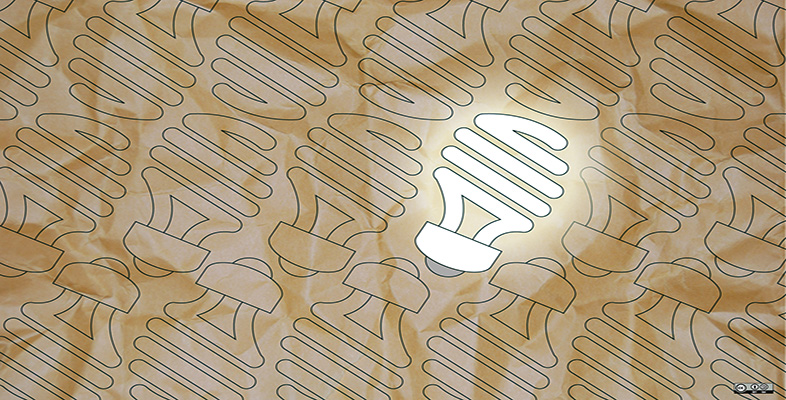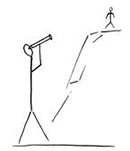2.2 Using representations
Activity 4 has illustrated the benefits of using multi-perspective visual representations to present and communicate ideas and concepts. Why does a representation, such as an image or a model, make a vision, idea or concept easier to understand and engage with? The old proverb says that a picture paints a thousand words, and there is truth to this. A representation is information-rich, it provides details not captured in a textual description. When information is presented in words we are left to read between the lines, to fill in the details. And often we do this erroneously, we can misinterpret the intention behind the words, and this can lead to confusion and complications. For example, consider the sentence:
I saw the man on the hill with the telescope.
(Simon, 1996, p. 79)
How did you interpret it? Who is holding the telescope? The phrase is ambiguous; it can be interpreted in different ways and it’s not clear who has the telescope: do I have the telescope? Does the man have the telescope? Or is the telescope on the hill? Visual representations give us additional details that fill in the gaps; they give additional context and can remove some of the ambiguity. For example, if the phrase is accompanied by a visual representation such as the picture in Figure 8 below, then we have a clearer idea about the situation.
But ambiguity is still not completely erased. Looking at the picture I can determine that a person is holding the telescope – so I know the telescope is not on the hill – but I still can’t determine who is holding the telescope. Perhaps it is me holding the telescope looking up at the man on the hill, or perhaps it is the man holding the telescope, and I am looking at him across a valley. The representation still needs further context! But, the fact that it is an external representation, rather than a visual picture in the mind’s eye, means that it can be pointed at, discussed and critiqued. In the image I can see many details at the same time, and can gain insight into the context and structure of the situation. I can ask the artist to label or annotate the image to identify where they think I am standing, and this will clarify the ambiguity, or at least provide a forum for discussing the ambiguity. As a device for supporting dialogue, a representation acts as a shared visual context that enables us to socially explore the depicted object or situation, through questioning and discussion.
In design meetings this dynamic is typical; visual representations are often the objects under discussion. Innovations are realised through design processes, and these are not usually conducted by designers working in isolation. Instead, it is common for designers to work in teams and to develop concepts in collaborative, social processes. Good design results from social interaction, for example between clients and designers, between designers and engineers or between members of design teams. Such interactions can be difficult because the different parties enter the dialogue from their own particular contexts, e.g. via consideration of enterprise, economics, aesthetics, ergonomics, physical properties or manufacturability. Complications can arise because participants in the dialogue have their own vision of an innovation, and their own language for describing it. Visual representations act as a bridging device to enable communication between the different parties. They provide the shared context that everyone in a meeting can engage with and discuss, as illustrated in Figure 9.
But the power of visual representations comes not only from their rich visual content, and their role as a communication device. Representations are also important tools for problem solving. Often the mere act of creating a representation of a problem immediately suggests a solution.
Activity 5 Visual problem solving
Consider the following puzzle, from Adams (2001, p. 4), and use the text box to write an outline of your proof.
One morning, exactly at sunrise, a Buddhist monk began to climb a tall mountain. A narrow path, no more than a foot or two wide, spiralled around the mountain to a glittering temple at the summit. The monk ascended at varying rates of speed, stopping many times along the way to rest and eat dried fruit he carried with him. He reached the temple shortly before sunset. After several days of fasting and meditation he began his journey back along the same path, starting at sunrise and again walking at variable speeds with many pauses along the way. His average speed descending was, of course, greater than his average climbing speed. Prove that there is a spot along the path that the monk will occupy on both trips at precisely the same time of day.
Answer
There are of course different ways to solve this problem, but the simplest is just to draw a diagram:
Here I have represented the journeys of the monk as he travels up and down the mountain, and superimposed the downward journey on top of the upward journey. The representation clearly shows that there is a single point where the two journeys cross, and at this point the monk is at precisely the same spot along the path at precisely the same time of day. QED, the statement is proved!
Discussion
Creating a visual representation allows us to abstract from the problem at hand, it makes us choose what information is pertinent and ignore superfluous details. If we can do this effectively, then the representation becomes a valuable and powerful tool for problem solving.
Psychological research tells us that our brains engage with information in different ways. Verbal thinking, through words, is just one way our brains process information. We also use visual thinking, which is based on imagery, and haptic thinking based on touch. These non-verbal cognitive processes enable us to understand information in different ways – to create metaphors that relate what we see and touch to things that look and feel similar. These alternative modes of thinking are very powerful and, as we demonstrated in Activity 5, can make a seemingly difficult problem suddenly obvious. Non-verbal thinking has been linked to creativity, and famous innovators, such as James Watt, Walter Chrysler and Albert Einstein, have identified their importance in exploring and developing their visions. Similarly, designers use representations as externalisations of their visual and haptic thinking, as a way to engage with the creative centres of their minds. Representations provide opportunities to engage with visions in a way that words alone cannot accommodate:
Many of the features and quality of the objects that a technologist thinks about cannot be reduced to unambiguous verbal descriptions; therefore, they are dealt with in the mind by a visual, non-verbal process.
Ferguson (1992, p. xi)



